Going Remote
The hectic nature of modern life has left many folks with a desire to return to the land and a fascination with remote living. Escaping to a little cabin in the woods to lead a more simple existence is a common fantasy. We have been lucky enough to experience it.
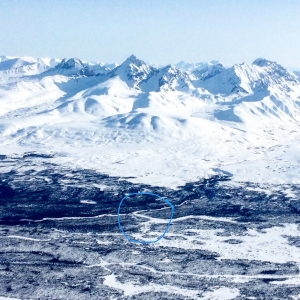
Home sweet home!
Probably the most common inquiry we get besides those asking about our vacation packages, are those looking for advice. Many folks send questions about living in the bush, finding land, and starting a remote homestead. These are all tricky questions. Beginning a remote homestead is a very personal undertaking. Everyone has different expectations and goals. Looking back on our experiences to date, I have come up with a few questions that I send to folks.
In this post, I will run through these questions. It is a little bit disorganized, but I think provides a fair amount of basic information.
We get lots of specific questions, as well, and I will answer those in a follow-up post.

View of flying into the Homestead in Late Fall.
⠀⠀Remote living Food for Thought
1. What does remote living mean to you and what do you think remote life “looks like?”⠀
2. What is your motivation for going remote? ⠀
3. Have you calculated a budget or thought about the cost?⠀
4. What are you willing to give up? Or, more importantly, what aren’t you willing to give up?
5. Realistically, what are you capable of? What skills do you need to achieve your vision? How are you going to get those skills?⠀
To preface, our particular situation is one of the more extreme. We are airplane only accessible, about 170 miles from the road and 70 from the nearest village. The parcel also lacked an access point. Keep in mind that there are as many ways to go about the whole remote-living, homestead “thing”as there are folks that live it. This perspective is one of many.
What does remote living mean to you and look like?
Remote means many things. Fly-in, Mush-in, Train-in, Hike-in, ATV-in, Boat-in. To me, remote means off the road system in a wilderness area. It means, to me, flying into town. It also means no sounds of the car, no easy access to stores, and no access to utilities. Remote living, to me, meant building our home, growing our food, having some kind of business and working with off-grid systems. Most importantly, it meant a deep immersion in the observations of the natural world. Most of these prerequisites could mean a place closer to a town. There are plenty of folks that check most of these boxes on a road near the highway.
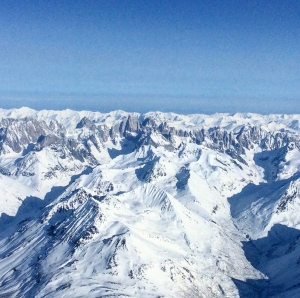
A favorite view on the “commute.” The Kichatnas
So, what does it mean to you? Does going remote mean an ATV ride down a dirt path? Does it mean not living in a large town? Or do you want to fly a bush plane? Spell it out.
What is your motivation for going remote?
Define your motivation. Once, when I was setting out on a long distance hike, it was recommended to me that I have a list of reasons for the “why.” I find this advice applicable to so many different tasks. Living remotely or homesteading is not easy. There will be many days when you want to throw in the towel. Having a list of your motivations to remind yourself why you are where you are will help you through the harder times. It will also help you choose the right place and situation for your wants.
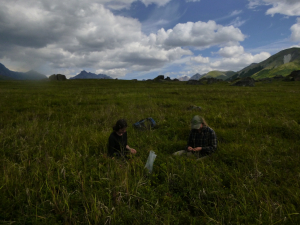
Collecting berries. Freedom, profound beauty, and delicious wild food.
Do you know what it will cost?
People often think that living remotely will be cheap. I think that this isn’t always true. The process of setting up can take a while. Those first few years may be expensive. Think about what you will need, and do some math. If you don’t want to leave the homestead while you are setting up, try to have at least 1-2 years of living expenses saved up prior to the move. A lot of people work at their homestead during the winter and leave to work during the summer. There are many permutations on the making a living in the bush.
Alaska is not cheap no matter where you live. Off the road system is even more expensive. In the village closest to us, Aviation gas currently costs $8.60/gallon, regular gas costs $6.90/gallon. A bag of chips costs an astounding $9.00.
On a more specific note related to cash… People think they will be able to forage, hunt, and grow all of their food. You can work towards that, but it likely won’t happen right away. Hunting and foraging cannot take place year round. It also takes a while to get a garden established and productive. At least for a while, you will be bringing in (at some expense), food from the store.
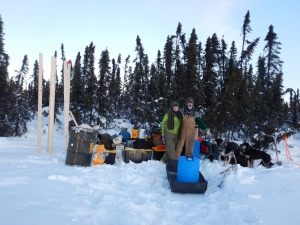
A winter’s supply of food and building tools.
“But hey,” you say, “weren’t there a lot of folks that went out with nothing and made a living back in the day?” Well, read their packing lists. They packed salt pork, coffee, beans, and rice. Additionally, there are Fish and Game regulations these days. You can’t just shoot a moose whenever you feel like it

Folks also think they can make a lot of money trapping bush. Well, just take a look at fur prices . Trapping can supplement your income a little bit, but there are very few people that make it full time as trappers these days.
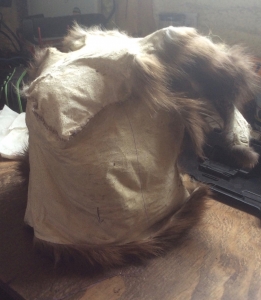
Trapped marten hat in progress. We make a few fur garments for ourselves and friends, but cannot make a living on it. I’m not sure I can think of anyone that does.
We were very lucky to have savings and work that came to our remote home for the first four years. Our homestead would look extremely different if we did not have that initial income. It would have taken much longer to achieve what we have were it not for that work. We currently work from time to time away from the homestead with various “side gigs.” We do not make a living 100% from the homestead. In most situations that is a great dream to work towards but don’t expect that to happen right away. Many folks, any least for a while, live part time on their homestead and work the rest of the year. If that is the case, you won’t need as much seed money to get started.

Burl bowl carved for sale
What are you willing to give up? What aren’t you willing to give up?
Are you willing to give up going out to the bar on the weekend? Coffee shops? Ordering food and your favorite coffee?
Are you willing to have to work for the basics: water, your heat source, your home. Everyone works. Coming home from work and turning up the thermostat is different from keeping a fire stoked round the clock.
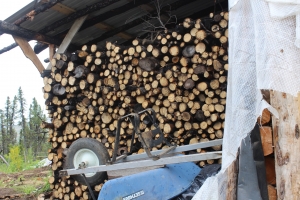
Part of the firewood stash
Think about it realistically. Some of the things you give up won’t be forever, some things will. For example, we went three years without the ability to get to town by our own volition. Travel was entirely dependent on someone else’s schedule. It was also fairly cost prohibitive. This resulted in less time with family and friends. That was extremely hard. Now that we have our own airplanes and airstrip, that situation looks very different. We will likely, however, never have Chinese food delivered.
Additionally, you won’t be able to anticipate many of the things that you might miss or all the things that you will love. Really thinking through what you are willing to sacrifice will help you define where you end up.
Most importantly (and kudos for making it this far in the post), what are you capable of? What skills do you need to achieve your vision? How are you going to get those skills?
Give yourself an honest look. What are you, realistically, capable of? I barely knew how to build a damn thing and have very basic construction skills. If I had gone out into the wilderness by myself six years ago and attempted to build a log cabin, it would not have gone well. Today, I might have an honest chance. Luckily, Morgan and I had skills that supported one another. He had an abundance remote building experience. So we built a cabin with material sourced on site.

Learning to build
So, as an example: If you don’t know how to build a cabin, how are you going to learn? Could you perhaps amend your goals to living on a property with an existing cabin?
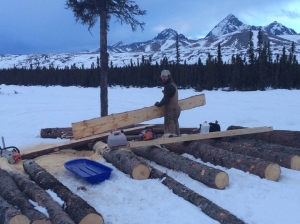
Milling Lumber with an Alaska Mill
Write out what you want to achieve on your property. Same example: You want to build a cabin. What will you need to know? Run a chainsaw and safely fell trees. Safely use and sharpen tools for peeling, limbing, notching. Clear land for a cabin. Etc. Etc. Go out and educate yourself.
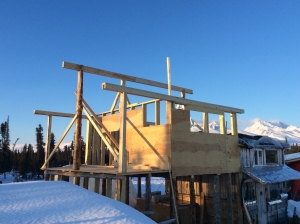
We have a few different structures on our property, all built with different methods and materials. Each one was an experience. They are rustic, imperfect, and suited to the circumstances
Keep in mind that “building a cabin” (or anything you do on a homestead) is not a one size fits all thing. Different building styles take different skills.
Final thoughts
Recommendations? Take every class you can find that would even peripherally benefit you. Read– ALOT. Talk to folks and ask them questions—ALOT of questions. One of my favorite things is to read old homestead books from Alaska. A lot of the writing is poor, but I always take away some interesting insights.
Also, take a Wilderness Medicine class and know how to use a map and compass.
Remote living comes in many shapes and sizes. It is not meant for everyone. Hell, I don’t think its for me everyday. Educating yourself and really articulating the reasons “why” will make the leap more feasible and enjoyable.
Please send questions. Let us know what information is helpful or not helpful. This is hard topic to write about and your input is welcome. What else would you like to know about remote living?
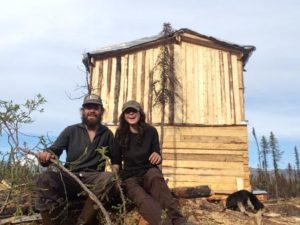
Our first structure on the homestead. We Did It! 2015
Two New Foals!
Homestead Living, Reflections, Updates from the Apricity HomesteadNew Icelandic Additions
It’s been a while since anything has been posted up on the blog. As with everyone, it has been a very different year for us. We are just now getting back into the swing of things, so expect many more updates on the horizon. For now, I’ll leave you with some cute photos of the baby Icelandic horses that joined the herd this summer.
Felagi: Means “Buddy”
Lutjia and Svanur’s colt, born May 25, 2020
Felagi is the first foal born at the homestead. We glassed a new figure from the deck of the homestead with the horses up in the high grazing meadows. Ketra (a farm volunteer) and I (Margaret), headed up to see if there was a new addition! Low and behold, this mighty mountain colt was teetering around the mountains with the rest of the herd. Here are a few shots of him– expect many more!
Felagi and Morgan in the yard
Felagi and Lutjia in the yard
Felagi at Three Months
Helga: Meaning “Strong”
Frilla and Vinur’s Filly, Born July 25, 2020
Helga ran down from the high grazing meadows to the homestead the day after she was born. That day, she went straight for the salt block just like her mother. She also kicked Morgan and the dogs when they came close. After realizing folks aren’t so scary, she gets her fill of ear scratches while around the homestead.
Helga and Frilla at the salt block, Day 1
Helga with the rest of the herd
Helga in the mountains at 3 weeks.
The horses are growing quickly and summer rapidly fading away. We saw our first stars in months this week– a sure sign that the summer is coming to a close.
Going Remote
Homestead Living, Homestead TipsGoing Remote
The hectic nature of modern life has left many folks with a desire to return to the land and a fascination with remote living. Escaping to a little cabin in the woods to lead a more simple existence is a common fantasy. We have been lucky enough to experience it.
Home sweet home!
Probably the most common inquiry we get besides those asking about our vacation packages, are those looking for advice. Many folks send questions about living in the bush, finding land, and starting a remote homestead. These are all tricky questions. Beginning a remote homestead is a very personal undertaking. Everyone has different expectations and goals. Looking back on our experiences to date, I have come up with a few questions that I send to folks.
In this post, I will run through these questions. It is a little bit disorganized, but I think provides a fair amount of basic information.
We get lots of specific questions, as well, and I will answer those in a follow-up post.
View of flying into the Homestead in Late Fall.
⠀⠀Remote living Food for Thought
1. What does remote living mean to you and what do you think remote life “looks like?”⠀
2. What is your motivation for going remote? ⠀
3. Have you calculated a budget or thought about the cost?⠀
4. What are you willing to give up? Or, more importantly, what aren’t you willing to give up?
5. Realistically, what are you capable of? What skills do you need to achieve your vision? How are you going to get those skills?⠀
To preface, our particular situation is one of the more extreme. We are airplane only accessible, about 170 miles from the road and 70 from the nearest village. The parcel also lacked an access point. Keep in mind that there are as many ways to go about the whole remote-living, homestead “thing”as there are folks that live it. This perspective is one of many.
What does remote living mean to you and look like?
Remote means many things. Fly-in, Mush-in, Train-in, Hike-in, ATV-in, Boat-in. To me, remote means off the road system in a wilderness area. It means, to me, flying into town. It also means no sounds of the car, no easy access to stores, and no access to utilities. Remote living, to me, meant building our home, growing our food, having some kind of business and working with off-grid systems. Most importantly, it meant a deep immersion in the observations of the natural world. Most of these prerequisites could mean a place closer to a town. There are plenty of folks that check most of these boxes on a road near the highway.
A favorite view on the “commute.” The Kichatnas
So, what does it mean to you? Does going remote mean an ATV ride down a dirt path? Does it mean not living in a large town? Or do you want to fly a bush plane? Spell it out.
What is your motivation for going remote?
Define your motivation. Once, when I was setting out on a long distance hike, it was recommended to me that I have a list of reasons for the “why.” I find this advice applicable to so many different tasks. Living remotely or homesteading is not easy. There will be many days when you want to throw in the towel. Having a list of your motivations to remind yourself why you are where you are will help you through the harder times. It will also help you choose the right place and situation for your wants.
Collecting berries. Freedom, profound beauty, and delicious wild food.
Do you know what it will cost?
People often think that living remotely will be cheap. I think that this isn’t always true. The process of setting up can take a while. Those first few years may be expensive. Think about what you will need, and do some math. If you don’t want to leave the homestead while you are setting up, try to have at least 1-2 years of living expenses saved up prior to the move. A lot of people work at their homestead during the winter and leave to work during the summer. There are many permutations on the making a living in the bush.
Alaska is not cheap no matter where you live. Off the road system is even more expensive. In the village closest to us, Aviation gas currently costs $8.60/gallon, regular gas costs $6.90/gallon. A bag of chips costs an astounding $9.00.
On a more specific note related to cash… People think they will be able to forage, hunt, and grow all of their food. You can work towards that, but it likely won’t happen right away. Hunting and foraging cannot take place year round. It also takes a while to get a garden established and productive. At least for a while, you will be bringing in (at some expense), food from the store.
A winter’s supply of food and building tools.
“But hey,” you say, “weren’t there a lot of folks that went out with nothing and made a living back in the day?” Well, read their packing lists. They packed salt pork, coffee, beans, and rice. Additionally, there are Fish and Game regulations these days. You can’t just shoot a moose whenever you feel like it
Folks also think they can make a lot of money trapping bush. Well, just take a look at fur prices . Trapping can supplement your income a little bit, but there are very few people that make it full time as trappers these days.
Trapped marten hat in progress. We make a few fur garments for ourselves and friends, but cannot make a living on it. I’m not sure I can think of anyone that does.
We were very lucky to have savings and work that came to our remote home for the first four years. Our homestead would look extremely different if we did not have that initial income. It would have taken much longer to achieve what we have were it not for that work. We currently work from time to time away from the homestead with various “side gigs.” We do not make a living 100% from the homestead. In most situations that is a great dream to work towards but don’t expect that to happen right away. Many folks, any least for a while, live part time on their homestead and work the rest of the year. If that is the case, you won’t need as much seed money to get started.
Burl bowl carved for sale
What are you willing to give up? What aren’t you willing to give up?
Are you willing to give up going out to the bar on the weekend? Coffee shops? Ordering food and your favorite coffee?
Are you willing to have to work for the basics: water, your heat source, your home. Everyone works. Coming home from work and turning up the thermostat is different from keeping a fire stoked round the clock.
Part of the firewood stash
Think about it realistically. Some of the things you give up won’t be forever, some things will. For example, we went three years without the ability to get to town by our own volition. Travel was entirely dependent on someone else’s schedule. It was also fairly cost prohibitive. This resulted in less time with family and friends. That was extremely hard. Now that we have our own airplanes and airstrip, that situation looks very different. We will likely, however, never have Chinese food delivered.
Additionally, you won’t be able to anticipate many of the things that you might miss or all the things that you will love. Really thinking through what you are willing to sacrifice will help you define where you end up.
Most importantly (and kudos for making it this far in the post), what are you capable of? What skills do you need to achieve your vision? How are you going to get those skills?
Give yourself an honest look. What are you, realistically, capable of? I barely knew how to build a damn thing and have very basic construction skills. If I had gone out into the wilderness by myself six years ago and attempted to build a log cabin, it would not have gone well. Today, I might have an honest chance. Luckily, Morgan and I had skills that supported one another. He had an abundance remote building experience. So we built a cabin with material sourced on site.
Learning to build
So, as an example: If you don’t know how to build a cabin, how are you going to learn? Could you perhaps amend your goals to living on a property with an existing cabin?
Milling Lumber with an Alaska Mill
Write out what you want to achieve on your property. Same example: You want to build a cabin. What will you need to know? Run a chainsaw and safely fell trees. Safely use and sharpen tools for peeling, limbing, notching. Clear land for a cabin. Etc. Etc. Go out and educate yourself.
We have a few different structures on our property, all built with different methods and materials. Each one was an experience. They are rustic, imperfect, and suited to the circumstances
Keep in mind that “building a cabin” (or anything you do on a homestead) is not a one size fits all thing. Different building styles take different skills.
Final thoughts
Recommendations? Take every class you can find that would even peripherally benefit you. Read– ALOT. Talk to folks and ask them questions—ALOT of questions. One of my favorite things is to read old homestead books from Alaska. A lot of the writing is poor, but I always take away some interesting insights.
Also, take a Wilderness Medicine class and know how to use a map and compass.
Remote living comes in many shapes and sizes. It is not meant for everyone. Hell, I don’t think its for me everyday. Educating yourself and really articulating the reasons “why” will make the leap more feasible and enjoyable.
Please send questions. Let us know what information is helpful or not helpful. This is hard topic to write about and your input is welcome. What else would you like to know about remote living?
Our first structure on the homestead. We Did It! 2015
Preserving Greens
Homestead Living, Homestead Tips, RecipesPreserving Greens for Winter
Today is March 1st. The cusp of spring. The garden has been resting under a blanket of snow since October, but soon enough planting will begin. I’ve been doing a lot of daydreaming about the coming garden season, putting in those final seed orders, and taking inventory of the past year’s harvests.
During our first years at the homestead, greens were sorely missed during winter months. We craved the taste of fresh plant life, eagerly awaiting the day when wild spring shoots burst from ground. When fresh food finally arrives, it is hard to eat enough of it!
Salad Season! Use it all: Edible flowers, wild and cultivate greens, radishes, and nuts. Photo Credit: Makiko Yoshida
This is the first year that we preserved enough homegrown greens to stretch all the way into the spring months. It may have been 5 months since the garden went to bed, but garden greens are still on the table.
Thinned beet greens bound for the table or the freezer. Photo Credit: Margaret Stern
Over the past few years, I have been experimenting with the best ways to preserve greens. I don’t like canned greens, and while I love krauts and other fermented greens, they don’t always hit the spot. Blanching and freezing is the best method I have found to add year-round, non fermented greenery to the homestead diet.
Blanching and freezing greens is not a new concept or terribly hard. It is time consuming, but worth the effort. The finished product makes a difference when trying to eat healthfully from the garden year round. It also makes the most of your hard work from the summer. I regularly process turnip, beet, kale and chard greens. Throughout the growing season, keep the nicest greens from thinning or harvest. The ones that aren’t eaten right away can be processed for winter.
Blanched and Frozen greens for the freezer. Single servings. Photo Credit: Makiko Yoshida
Blanching and Freezing Greens
Materials:
Fresh-Hardy Greens, Cutting Board, Knife, Stock Pot of Water, Pot of Cold Water, Strainer, Containers (Ziplock bags, jars, or VacuumSealer Bags)
In years past, I did not make the greens into single serving. That was a mistake. I ended up with huge gallon Ziplock bags that required me hacking chunks off of the solid green clumps with an axe. Squeezing and freezing the greens into single, fist sized portions works incredibly well. You don’t have to defrost an entire bag or break out the axe. About 16 fist sized serving fit into a gallon ziplock bag. I also experimented with making flat “cookie” shaped servings to fit into canning jars as a way to cut down on plastic use.
You may wonder why you can’t just throw fresh greens into the freezer and call it a day. If left uncooked, enzymatic action continues to act upon the vegetables resulting in a loss of taste, texture, and color. When blanching, the cooking is done quickly enough that the veggies don’t get mushy. They remain crisp and flavorful until you are ready to eat them.
Ways to enjoy blanched greens? Toss them in pasta, quiche, sauté before frying eggs, put in soup, stews, and anywhere you would want cooked greenery!
Beasley Family Heart Recipe
Homestead Living, Homestead Tips, RecipesBeasley Family Heart Recipe
Happy Valentine’s Day!
Spruce Root Hearts Photo Credit and Creator: Caity Potter
The first fall Morgan and I were dating, he went on a caribou hunt with friend Evan of Talkeetna 4×4 Adventures check them out. He is an awesome guide and all around great guy. That epic hunt is a story worth telling over and over again…. But that is not my story to tell.
When Morgan called to say he had had a successful hunt, I was excited to experiment with cooking caribou. Never before had I tasted this kind of wild game and wanted to try it all. For a first introduction, he said he was going to make a Beasley specialty.
Read more
Apricity: What’s in a Name?
Reflections, Updates from the Apricity HomesteadApricity: The feeling of the warmth of the sun in winter
Horses soaking in the late fall sun.
It was April. Break-up season. The snow so rotten you couldn’t take a step without falling in up to your waist. We were home-bound, travel too difficult to make any progress on our projects. The lumber was milled and ready for construction and the homesite selected. The gear was moved off the lake and summer loomed brightly around the corner. Now, after months of go-go-go, we gratefully accepted a time of rest. Now, we waited for the flip of the seasonal switch.
Read more
Solitude.
Homestead Living, ReflectionsSeasons at the homestead contrast sharply from one another. This is not due solely to the weather swings of -55 to 90 degrees from winter to summer, but because of the nature of work and activity that each season brings. Most different are the times spent alone in the winter contrasted with the flurry of guests, volunteers, and friends that summer brings. In the summer, it is not unusual to have up to 5 people at a time visiting the homestead. Winter, it is common to spend a few weeks apart running errands, visiting family, and visiting friends in town.
Read more
November News: Water Works!
Homestead Living, Updates from the Apricity HomesteadAfter years of planning, a water pump was installed in our new addition during November. This marks a huge improvement in our year-round Water System.
In Summer, water requires much less forethought and labor to access. We have a small, energy efficient, pump that draws water from our creek for drinking, wash water and into the hoses and sprinklers that irrigate our 6,000 square foot garden. A camp hot water heater provides incredible outdoor showers, or choose to embrace the wild and bathe in the creek. Summer is a time of ease of access to that stuff of life.
Read more
Well-Fed: Food on the Homestead
Homestead Living, Homestead TipsWell-Fed: Food on the Homestead
Where does it come from? How is it stored?
Nothing like fresh salad! Photo Credit: Makiko Yoshida
To us, self-sufficiency means providing most of our own food. In most cases, food sourced by your own hand is affordable, healthy, and more delicious. Once you have tasted fresh lettuce out of the garden or a perfectly ripe strawberry, any other will pale in comparison. You are serving up great rewards when you eat a meal composed solely of ingredients you harvested from your garden.
Read more
Life Dictated by Fall Flyable Weather
Updates from the Apricity HomesteadLife Dictated by Flyable Weather
October. A month of weather. Ice fog blanketed the landscape for days. When it lifted, the snow fell. When the snow stopped and the clouds cleared, temperatures dropped, and the wind howled. October consistently dishes out the worst weather we see.
Read more
Water System Update, Final Harvests, Friends
Updates from the Apricity HomesteadWater System, Final Harvests, Friends September 2018 September was a unique month for us at the homestead… and away from the homestead. During the beginning of the month, Morgan laid insulated pipe for our gray water system. We are increasingly closer to running water at the homestead! The pieces are all coming together. During […]